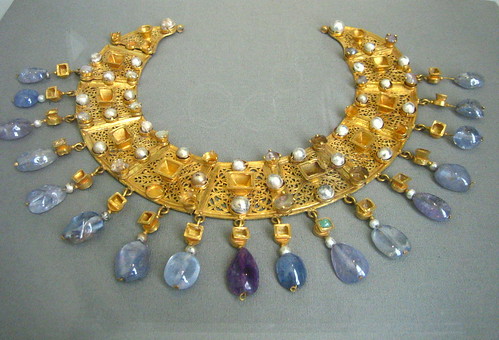I ran across this particular piece on Pinterest, and think it interesting that it's superhumeral-shaped. What if superhumerals are not fabric, but metal?
I'm intrigued, as one of my inspiration pieces for my persona is Theodora with Attendants, which is a sixth century Byzantine mosaic in Ravenna, Italy. In that piece, the Empress is wearing what appears to be a separate collar, but with bezels and the like. Attaching said bezels to fabric is tricky, and can damage delicate fabrics (like silk). If it is a metal piece, like this, it makes more sense. Further more, the Berlin necklace has the same sorts of drops, similarly shaped bezels and prong settings, and does have pearl beads inset into bezels - much like Theodora's collar.
One thing I do find interesting is the loops on the back of the necklace. I'm thinking that this may have been tied shut and was therefore adjustable. It also could have been sewn to a fabric backing.
Also in the realm of cool are the headpins - which are really just eye pins folded under. The piercework is amazing, and the teeny-tiny hinges are gorgeous. I really, really want to try to make this piece.
It's something to think upon some more.

I feel that this makes so much sense, also the idea of tying it/making it adjustable, somehow
ReplyDeleteIt does. What's hard here is that there's not a lot of surviving superhumerals. What we have are things like "necklaces", and I'm honestly thinking that this might be more related to a superhumeral than what they're being called.
DeleteMandy and Rachel -
DeleteYES, necklaces were tied shut in period. Almost every surviving piece of pre 1800 jewelry I've found has loops at the end, with the exception of Roman and Byzantine, which used the hook and eye. I finally found pictorial evidence in a portrait just a week or two ago. The portrait is from late 16th century and shows a lady with her female attendants dressing her - one is picking up a necklace of pearls or other beads that is clearly suspended from two ribbons on the ends. It's on my pinterest boards under Jewelry in Renaissance paintings, I think. (pinterest.com/fionasfancies) I've got tons more photos of pieces that show the loops on the ends. Hope that's helpful.
Heather / Fiona
Excellent - makes sense!
DeleteWith this being Byzantine (which, let's face it, is just Eastern Roman), I'm wondering if there's a structural reason for it to not have the hook and eye (such as a reason to adjust it or it's simply just too heavy for a single hook and eye).
I'll have to check it that portrait soon! Thanks for pointing that out!